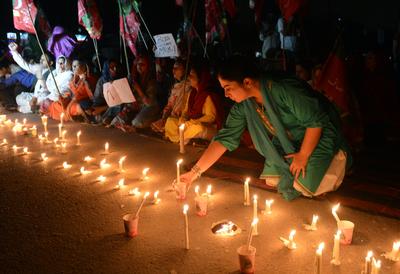to protect 70,000 polling stations, half of which were considered to be in ‘sensitive’ locations and vulnerable to attack. Despite heightened security, voting was marred by violence: at least 38 people were killed and over 130 were injured. The Election Commission of Pakistan had to defer elections for three seats of the National Assembly and six seats of the provincial assemblies because candidates had died — some of natural causes; others were killed. Many candidates were kidnapped, including former Prime Minister Yousaf Raza Gillani’s son, who was taken by militants while campaigning for a seat in Multan.
Despite the threat of violence, over 60 per cent of Pakistan’s 86 million registered voters (including 36 million newly registered voters) waited in long lines in the hot sun for the chance to vote — one friend told me that she waited three hours to cast her ballot.
The 2013 elections saw twice as many female candidates in the running than in 2008 and women voted in record numbers. Still, for a country that has had a female prime minister and has 60 seats reserved for women in Parliament, women’s democratic participation is still stifled in some parts. In many conservative areas religious clerics banned women from voting, threatening violence against them and their families if they disobeyed. In Lower Dir, in the province of Khyber Pakhtunkhwa, political parties made secret deals with militants to prevent women from voting. According to the Gender Election Monitoring mission, not a single woman voted in six polling stations in Lower Dir, while in Upper Dir only a single woman cast her vote.
Dawn, the English daily, interviewed voters after they had cast their ballots, revealing many who were sick of the status quo. One voter in Chakwal said: ‘We are fed up with PML-N (Pakistan Muslim League Nawaz) and PPP (Pakistan People’s Party). Now we want change, which only Imran Khan can bring’. Another voted for religious party Jamaat-e-Islami (JI), reasoning that ‘JI is the only party that can bring an Islamic system to the country’. But in the end the PML-N won the most seats, with voters backing Nawaz Sharif. One voter, who cast his ballot for PML-N said, ‘Only experienced people can rid the country from the prevailing crises, not newcomers’.
There are definitely some quirks to the Pakistani electoral system that don’t exist in other countries — the biggest being that candidates can try their luck in more than one constituency. For example, cricketer-turned-politician Imran Khan, leader of Tehreek-e-Insaf (PTI), stood for election in four federal seats, winning three. The leader of PML-N, Nawaz Sharif, stood in two electorates, while the former PPP foreign minister Shah Mehmood Qureshi stood in four seats, but this time running on the PTI ticket. Candidates choose which seat they want to keep, with the leftover seats re-contested in by-elections.
The incumbent party, the PPP, did not hold on to enough seats to form government. Its failure can’t just be attributed to the defections of senior party members like Shah Mehmood Qureshi to the PTI. In addition to being tainted by corruption and being perceived as incompetent, the party leadership could do little campaigning in public because of merciless threats from the Taliban. The party’s leader, 25-year-old Bilawal Bhutto, remained holed up in Dubai for most of the campaign because the risk of assassination was too great for him to appear anywhere in public.
Following the election the horse-trading has begun as the PML-N and Nawaz Sharif work to pull together a coalition government. Nawaz is an experienced politician and has led Pakistan twice before, in 1990–93 and in 1997–99. His second term was cut short, when he was ousted by a military coup. Most predict the Army will leave this PML-N-led government alone — simply because the military leadership are not interested in fixing Pakistan’s myriad political, economic, security and social problems.
It will be telling what the PML-N decides to prioritise during its first 100 days in office. There are signs that relations with India will improve. Indian Prime Minister Manmohan Singh has already invited Nawaz to visit India, while the party has promised a broad review of foreign policy in the coming months. The party promised to bring about an ‘economic revolution’ and ran on a platform of economic revival. Traders and industrialists are at the heart of PML-N’s support base, and Nawaz Sharif is a successful businessman in his own right, making billions in the steel industry. But pundits will have to wait to see if the government can implement successful policies to overcome Pakistan’s deep economic malaise. Stay tuned for what Pakistan’s new government can do for the people of Pakistan.
Alicia Mollaun is a PhD candidate at the Crawford School of Public Policy, Australian National University, and is based in Islamabad.

